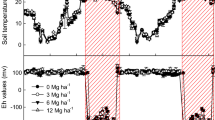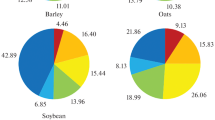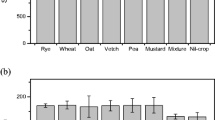Summary
Total annual input of carbon with crop residues to the soils in Missouri (North Central Region of the USA) was found to be about 3.7 t ha−1 for wheat, 3.4 t ha−1 for soybeans and 9.2 t ha−1 for corn. Root biomass represented 40–50% of total residues and its accumulation appears to be influenced by climatic conditions. Estimates of carbon outflow from the ecosystem in the form of CO2 were in good agreement with the biomass input.
Similar content being viewed by others
References
Barber S A 1979 Corn residue management and soil organic matter. Agron. J. 71, 625–627.
Beaver J S and Cooper R L 1982 Dry matter accumulation patterns and seed yield components of two indeterminate soy bean cultivars. Agron. J. 74, 380–383
Borst H L and Thatcher L E 1931 Life history and composition of the soybean plant. Ohio Agr. Exp. Sta. Res. Bull. 494, 96 pp.
Böhm W 1979 Methods of studying root systems. Springer-Verlag, Berlin-Heidelberg-New York. 182 p
Bray J R 1963 Root production and the estimation of net productivity. Can. J. Bot. 41, 65–72.
Buyanovsky G A, Kucera C L and Wagner G H 1985 Comparative carbon balance in natural and agricultural ecosystems. Bull. Ecol. Soc. Am. 66, 22, 149–150.
Coleman D C 1976 A review of root production processes and their influence on soil biota in terrestrial ecosystems.In The Role of Terrestrial and Aquatic Organisms in Decomp. Processes. Eds. J M Anderson and A Macfaden. The 17th Symp. of the British Ecol. Soc. Blackwell Sci. Publ. pp. 97–144.
Coleman D C, Reid C P P and Cole C V 1983 Biological Strategies of nutrient cycling in soil systems. Adv. Ecol. Res. 13, 1–57.
de Jong E and H J V Schappert 1972 Calculation of soil respiration and activity from CO2 profiles in the soil. Soil Sci. 113, 328–333.
Hanway J J and Weber C R 1971 Dry matter accumulation in eight soybean (Glycine max (L) Merril) varieties. Agron. J. 63, 227–230.
Iwaki H 1974 Comparative productivity of terrestrial ecosystems in Japan with emphasis on the comparison between natural and agricultural systems.In Structure, Functioning and Management of Ecosystems. Proc. 1st Intern. Congress of Ecology, Wageningen, pp 41–45.
Jenkinson D S and Rayner J H 1977 The turnover of soil organic matter in some of the Rothamsted classical experiments. Soil Sci. 123, 298–305.
Koehlein J and Vetter H 1953 Ernterückstände und Wurzelbild. Hamburg Berlin, Parey, 178 p.
Kononova M M 1966 Soil organic matter. 2nd English ed. Pergamon Press, Oxford, 544 p.
Larson W E, Clapp C E, Pierre W H and Morashan Y B 1972 Effects of increasing amount of organic residues on continuous corn. II. Organic carbon, nitrogen, phosphorus and sulfur. Agron. J. 64, 204–208.
Loomis R S and Gerakis P A 1975 Productivity of agricultural ecosystems.In Photosynthesis and Productivity in Different Environments Ed. J P Cooper. Cambridge Univ. Press. pp. 145–172.
Mayaki W C, Teare I D and Stone L R 1976 Top and root growth of irrigated and nonirrigated soybeans. Crop Sci. 16, 92–94.
Methods of Soil Analysis 1982 Part 2, Second Edition. Agronomy Series, 9. ASA-SSSA, Madison, Wisconsin, 1159 p.
Mitchell R 1984 The ecological basis for comparative primary production. pp. 13–54.In Agricultural Ecosystems. Unifying Concepts. Eds. R Lowrance, B R Stinner and G J House. J. Wiley and Sons, New York, 233 p.
Mitchell R L and Russell W J 1971 Root development and rooting patterns of soybean (Glycine max (L) Merrill) evaluated under field conditions. Agron. J. 63, 313–316.
Ovington J D, Heitkamp S and Lawrence D B 1963 Plant biomass and productivity of prairie, savannah, oakwood, and maize field ecosystems in Central Minnesota. Ecology 44, 52–63.
Pasternak D 1974 Primary production of field with winter wheat. Ekologia Polska 22, 2, 369–378.
Sauerbeck D R and Johnen B G 1977 Root formation and decomposition during plant growth. Soil Organic Matter Studies, Proc. Symp. IAEA, FAO and Agrochimica in Braunschweig, Sept. 6–10, 1976. IAEA, Vienna.
Sivakumar M V K, Taylor H M and Shaw R H 1977 Top and root relations of field-grown soybeans. Agron J., 69: 470–473.
Thorne D W and Peterson H B 1954 Irrigated soils; their fertility and management. 2nd ed. The Blakston Co, New York, 392 p.
Tubaileh A S, Lugg D G and Sammis T W 1984 Relationships between evapotranspiration and rooting patterns of spring barley. Agron. Abstr., 117.
Van Dobben W H 1962 Influence of temperature and light conditions on dry-matter distribution, development rate and yield in arable crops. Neth. J. Agric. Sci. 10, 5, 377–397.
Warembourg F R and Paul E A 1977 Seasonal transfers of assimilated14C in grassland: plant production and turnover, translocation and respiration. pp. 133–149.In The Below-ground Ecosystem: a Synthesis of ‘Plant-Associated processes’. Ed. J K Marshall. Range Sci. Dept., Sci. Series No 26, Colorado State University, Fort Collins.
Whittaker R H and Marks P L 1975 Methods of assessing terrestrial productivity. pp. 55–118.In Primary Production of the Biosphere. Eds. H Leith and R H Whittaker. Springer, New York.
Whipps J M 1984 Environmental factors affecting loss of carbon from the roots of wheat and barley seedlings. J. Exp. Bot. 35, 155, 767–773.
Author information
Authors and Affiliations
Additional information
Contribution from the Missouri Agricultural Experiment Station Journal Series Number 9842. Funded in part by the USDA Grant SE 83-CRSR-2-230.
Rights and permissions
About this article
Cite this article
Buyanovsky, G.A., Wagner, G.H. Post-harvest residue input to cropland. Plant Soil 93, 57–65 (1986). https://doi.org/10.1007/BF02377145
Received:
Revised:
Issue Date:
DOI: https://doi.org/10.1007/BF02377145




